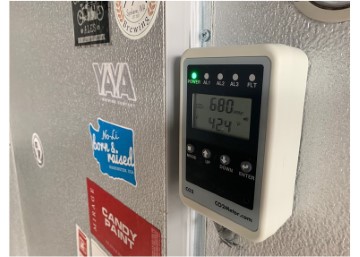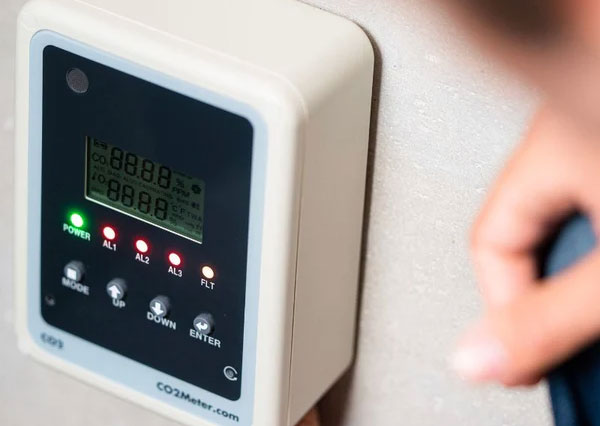carbon dioxide alarm
a CO2 alarm for workplaces, including pubs, breweries, cafes, restaurants, laboratories
overview
- The ESRAD-102 Carbon Dioxide Alarm is the product that is required by workplaces where carbon dioxide (CO2) gas cylinders or dry ice are stored in confined spaces such as storage areas, basements, cool rooms or laboratories.
- Ideal for cellars, basements, enclosed areas in pubs, clubs and restaurants
- Ideal where dry ice is used in the workplace.
- Comply with workplace safety standards AS5034-2005
- Audible and Visual Alarms
The ESRAD-102 Carbon Dioxide Alarm is designed to protect you and your staff near stored carbon dioxide (CO2).
Workplace safety regulations require the installation of a carbon dioxide alarm when there is CO2 gas cylinders present. This is known as workplace safety standard AS5034-2005. The ESRAD-102 Carbon Dioxide Alarm complies with the workplace safety regulations.
Carbon dioxide alarms are critical in laboratories, cool rooms, wastewater treatment facilities, breweries, wineries, beverage dispensing areas, restaurants, fast food establishments, dry ice storage, storage tanks, or anywhereCO2 is stored or produced in high volume.
The ESRAD-102 has audible and visual alarms. The ESRAD-102 also has 2 built-in relays that can trigger the alarms at different user-defined CO2 levels, as well as control a ventilation fan or an HVAC control switch to notify maintenance staff of high CO2 levels. This meets the OSHA PEL (Personal Exposure Limit) Standard of 5,000ppm TWA (time-weighted average) in a typical 8-hour workday.
The ESRAD-102 Carbon Dioxide Alarm is easy to install and use. Simply mount both units on the wall (all cables and hardware included), plug the display unit into a standard wall jack, and the alarms are ready to protect you and your staff.
carbon dioxide alarm models:
features
- Remote Display Unit using 8m RJ45 cable (included).
- Large digital LCD display clearly indicates the current CO2 level and temperature.
- Model ESRAD-102SX2 only: (2) 100 cd strobe lights w 2m cables for additional visual notification of alarm.
- 2 relays to control ventilation fan(s) or provide remote monitoring.
- Built-in 80dB audible and visual alarm indications.
- IP54 Enclosure - prevents water damage during wash-down.
installing the carbon dioxide alarm
 Your site assessment should consider four factors to insure proper installation of the carbon dioxide alarm.
Your site assessment should consider four factors to insure proper installation of the carbon dioxide alarm.
Prior to your site assessment, it is recommended that you inquire about and understand the local and state codes that may now require specific additions to monitors. Adding strobe lights for additional visual notification is the most common addition. Some jurisdictions are also requiring that monitors be tied to the fire alarm panel to trigger an automatic call to the local Fire Department to warn of a CO2 leak. Meeting these new requirements is not optional, You will be fined if these requirements are not met.
Different applications allow for different coverage areas.
enclosed beverage systems
In these applications monitors cover approx. 1,250 sq. feet (length x width of the space). Typically, placement within 10 feet of the bulk CO2 storage tank, cylinders, and the BIB rack is sufficient. Larger spaces may require additional monitors. Enclosed rooms/spaces (closets, offices, bathrooms, and keg coolers) may require additional monitoring as gas can be trapped in these spaces because of the enclosure.
purposefully enriched areas
Applications where CO2 is intentionally injected into a space (called enrichment) will allow for larger coverage areas. Indoor agriculture usage will allow for larger coverage areas because of the continuous circulation of the environment. In these applications a gas detection monitor can effectively cover less than 2,000 sq. feet (length x width of the space).
However, each installation should be considered individually to account for the particular layout and any varying or enclosed spaces within the footprint.
where should the carbon dioxide alarm be mounted?
Once you know the approximate location of the sensors, the confined space, and how many you'll require, the next step is to determine where to mount them.
Think of CO2 flowing like water. Water will fill a cup from the bottom upwards. The same will happen in interior spaces like cool rooms, restaurants, breweries, and grow facilities.CO2 gas is heavier than air. Therefore, CO2 gas will flow downstairs or collect in low lying areas first. For this reason, the ESRAD-102 Carbon Dioxide Alarm unit should be mounted no higher than 45-60 cm above the floor.
The next consideration is power. The ESRAD-102 is typically connected to a mains power supply on the wall. Therefore, the ESRAD-102 is usually mounted near a power outlet. A qualified electrician can hardwire the ESRAD-102 into the building's electrical circuit.
Importantly, the carbon dioxide alarm should be mounted in such a way that it cannot be accidentally damaged when moving boxes, crates or gas cylinders nearby. In addition, if using the power adapter, ensure that the plug is secured to the wall to insure staff does not accidentally or purposefully unplug the alarm.
installing the CO2 remote display
 Both the main device and remote display unit have audible and visual alarms. However, while the main carbon dioxide alarm monitors in an enclosed area where a potential CO2 leak could occur, the Remote Display is designed to be mounted outside the space and to warn staff of a potential gas leak before entering the area.
Both the main device and remote display unit have audible and visual alarms. However, while the main carbon dioxide alarm monitors in an enclosed area where a potential CO2 leak could occur, the Remote Display is designed to be mounted outside the space and to warn staff of a potential gas leak before entering the area.
Remote displays are best mounted at eye level near the door frame of any door entering the enclosed area. They should be mounted on the same side as the door handle to insure they are not covered when the door is open.
Our CO2 Safety Monitors can daisy-chain up to 3 remote displays to a single CO2 sensor unit. However, if there are more than 3 entry doors, a second CO2 sensor unit will be required.
safety signage
Once the CO2 Sensor Unit and Remote Display(s) are installed, you should also install safety signage at every door. The signage should be visible whether the door is opened or closed. All our CO2 Safety Monitors come with the necessary safety signage.
Note that the suggestions above are best practices gained from experience but are not an endorsement of any specific location in your building. Every installation is different. If you have questions about your installation, contact your local building inspector or workplace safety officer.
specifications
| feature | specification |
|---|---|
| Measurement Principle | NDIR (Non-Dispersive Infra-Red) |
| Measurement Range | 0-5% (50,000ppm) |
| CO2 Alarm Set Points | Relay 1: 1.5%. Relay 2: 3% CO2 (configurable) |
| Alarm | Audible @ 80 dB | Visual with LED lights |
| Operating Temperature | 0 to 50 °C |
| Calibration | Check every 6 months | Fresh air calibration |
| CO2 Sensor Lifetime | approx. 15 years |
| Power Supply | 110-240 VAC to 6 VDC Adapter |
| Power Consumption | 3 Watts |
| Relays | Peak Current < 2A @ 30VDC or 250VAC, SPDT |
| Warranty | 1 year |
manual & docs
related products









